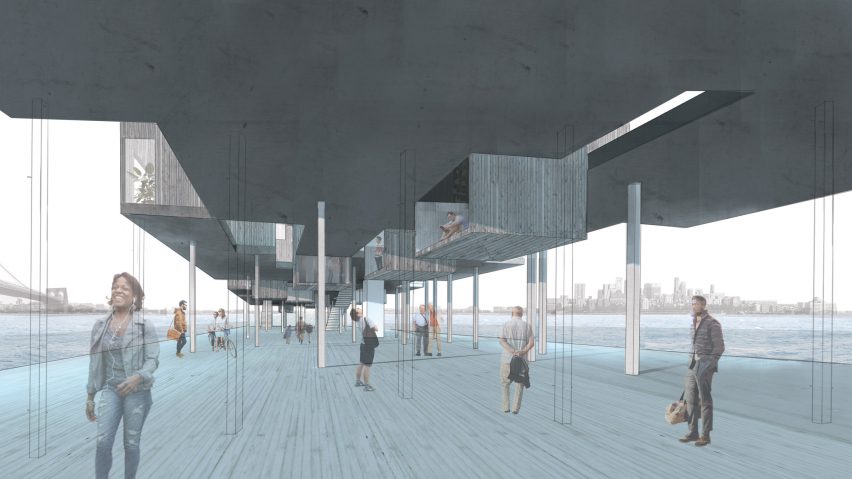
University of North Carolina Charlotte spotlights 10 architecture projects
A museum that pairs monitoring soil with artistic research and a women's home that offers pregnant women and mothers a space for empowerment are included in Dezeen's latest school show by the University of North Carolina Charlotte.
Also included is the transformation of an industrial site into a community arts hub and a project that examines eye-tracking technology to observe how individuals perceive interior space.
University of North Carolina Charlotte
School: School of Architecture, College of Arts and Architecture, UNC Charlotte
Courses: Studio and Labs, Master of Architecture and Master of Science
Director: Professor Blaine Brownell
School Statement:
"The mission of the UNC Charlotte School of Architecture is to promote excellence in architecture and urban design education, scholarship, and practice in an inclusive and collaborative environment.
"One of two accredited architecture programmes in North Carolina, the UNC Charlotte School of Architecture capitalises on its location in one of the fastest-growing and most diverse cities in the United States.
"Students and faculty at the UNC Charlotte School of Architecture contribute to six primary areas of distinction intended to inform the discipline's future.
"Regenerative systems design aims to increase the environmental performance of the built environment by partnering with living systems and exploring architecture's role in the delivery and replenishment of ecosystem services.
"Social justice futures advance dimensions of diversity, equity, and inclusion via community partnerships in the form of speculative and projective design proposals.
"The applied critical history extends the role of history beyond the classroom, engaging fundamental contemporary issues of cultural and environmental importance.
"Together, these areas of distinction contribute to our goals of linking academic excellence and access, preparing students to be entrepreneurial change agents, and expanding the disciplinary capacities of architecture in advancing social, technological, and environmental justice."
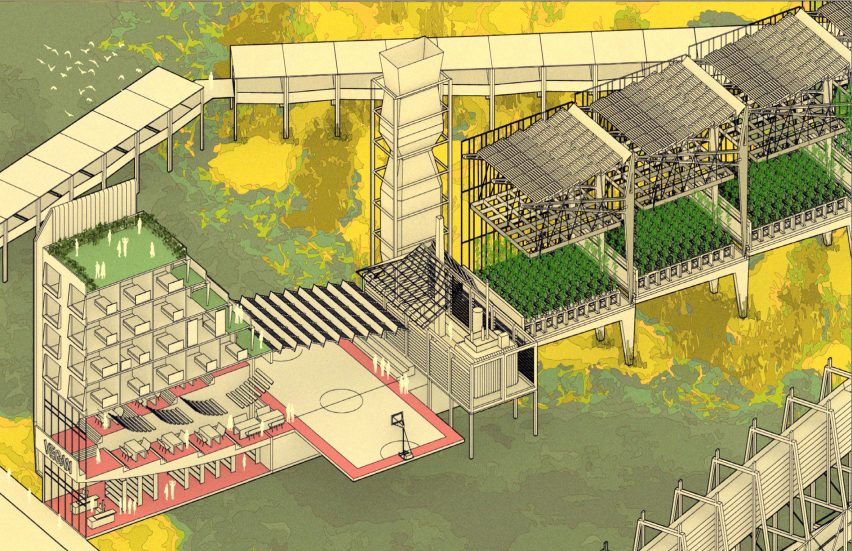
Vegan Labs: Utopia in Practice by Pedro Pinera-Rodriguez
"Eli Mask, extravagant billionaire entrepreneur owner of several successful break-through tech companies, after a spiritual journey across East Asia, concludes the best way to slow down the ecological catastrophe is for the global population to shift to a meatless diet.
"This project is the creation of a meatless ground zero with research and cultural programs supporting its vision. After successful negotiation with the City of Chicago, the site of Bubbly Creek, the former epicentre of the American meat-processing industry, was selected as the headquarters of Vegan Labs.
"In exchange for cleaning the heavily polluted grounds and water and developing a world-class research and cultural facility, the mayor agreed to a 100-year lease on the site, and a 50-year tax break on all economic activity within this new principality with its own laws, security, and social services, and infrastructure."
Student: Pedro Pinera-Rodriguez
Course: Diploma Studio, Master of Architecture
Tutor: Chris Jarrett, professor
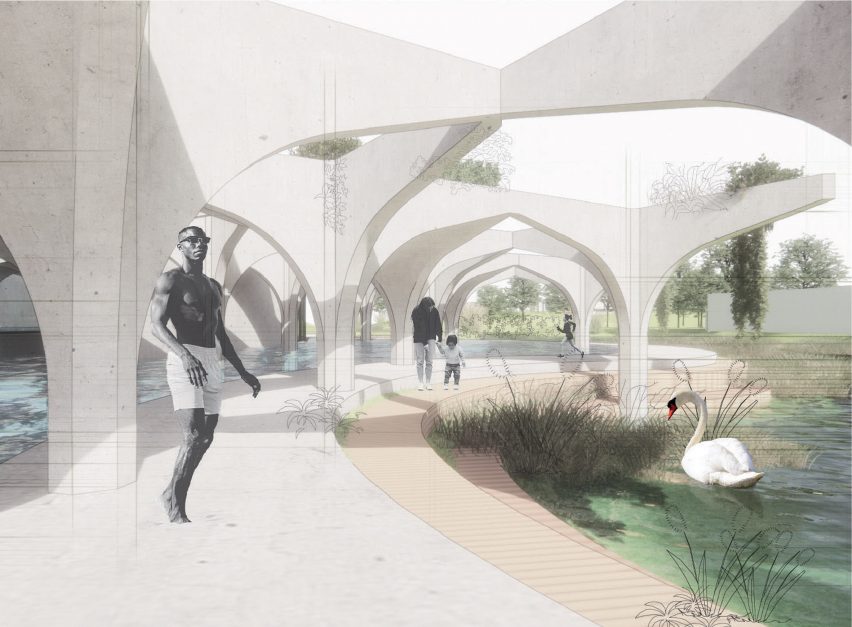
Rivalis by Meredith Nortz
"Charlotte's ageing, privately-regulated water infrastructures put community health at risk. Water with high levels of contaminants is being consumed at unsustainable rates.
"Rivalis harnesses purified industrial wastewater for the creation of a hydrotherapeutic commons of health in the form of a public bath connecting the underserved Thomasboro-Hoskins neighborhood to the previously-hidden Stewart Creek."
Student: Meredith Nortz
Course: Diploma Studio, Master of Architecture
Tutor: Frances Hsu, visiting associate professor
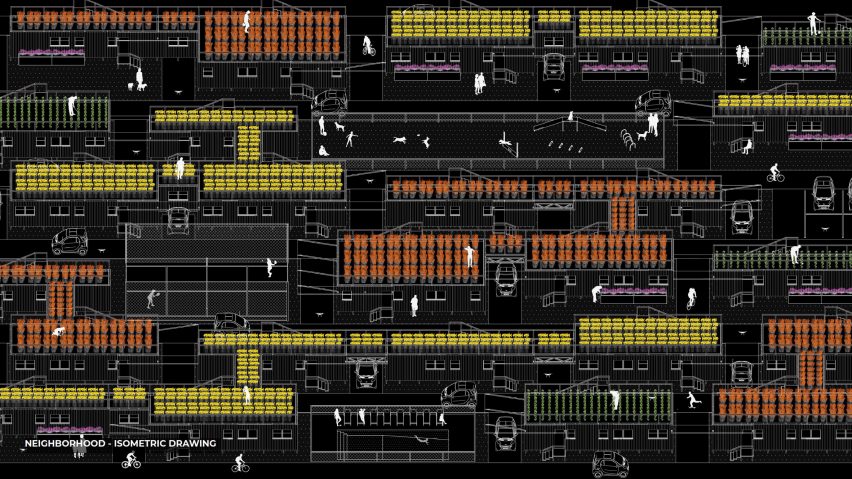
Farm-to-trailer by Daniel Lutarewych
"David W Teague argues that suburbanisation is a continuous ideological motivated migration.
"Resources and undeveloped land are devoured to feed this outward growth, with cities suffering from individuals withdrawing from their more significant communities.
"Utilising the abandoned site of the former mall complex, farm-to-trailer pairs low-rise, high-density housing with agricultural production.
"By deconstructing and reforming the same conditions of a typical suburban development at both the home and neighbourhood scale, the community is bred rather than insularity. This is a true farm-to-table community."
Student: Daniel Lutarewych
Course: Diploma Studio, Master of Architecture
Tutor: Chris Jarrett, professor
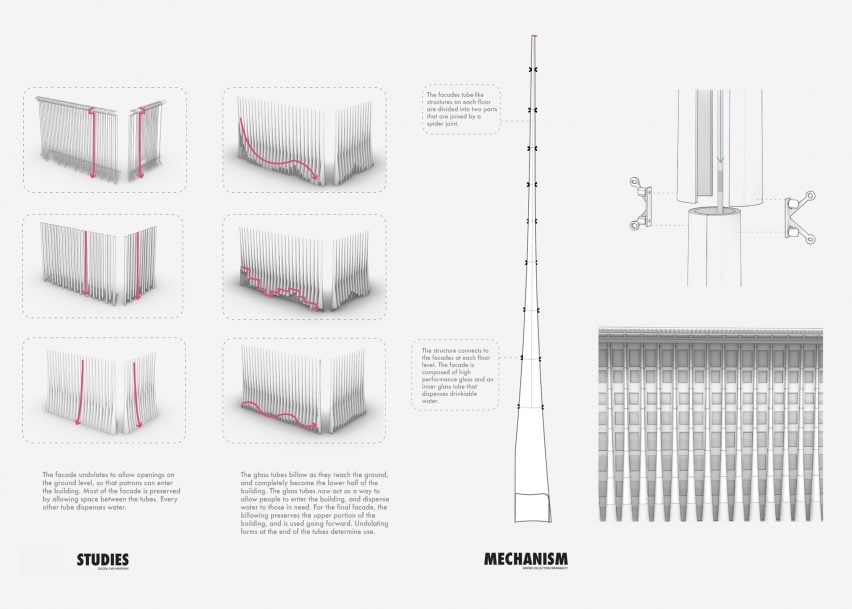
Mpala by Teddie Gourdet
"Based on quality-of-life research within New York City's five boroughs and more specifically Midtown Manhattan, this facade-based project manages storm and drinking water.
"A more sustainable means is required for water collection and the means for hydrological systems in metropolitan areas.
"The vertical surfaces of buildings provide a different and more challenging opportunity for water collection due to a facade's multiple functions - e.g., glazing surfaces, HVAC control, energy collection, shading effects, etc.
"This facade strategy aims to resolve issues of gathering and using non-potable and potable water surrounding the urban site."
Student: Teddie Gourdet
Course: Diploma Studio, Master of Architecture
Tutor: Kyoung Hee Kim, associate professor
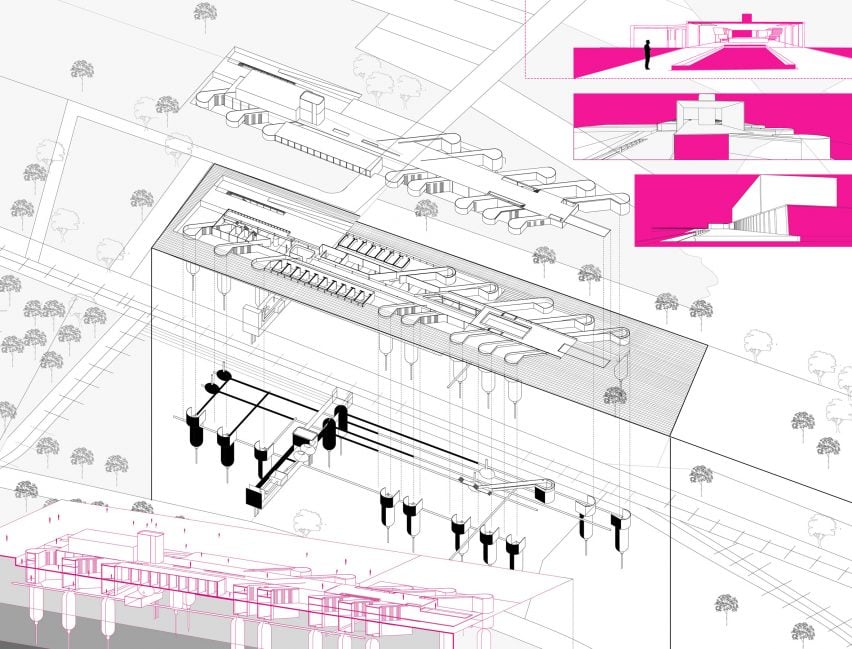
Unknown Lands by Negar Amini
"Unknown Lands is a response to the global land degradation crisis in which the environmental and extractive logics of toxicity in the soil remain unidentified.
"A museum that combines mechanisms for soil monitoring and remediation with spaces hosting artistic research experimentation and exhibition can reframe the multifaceted ecological, political and humanistic meanings of soil/earth/ground/land."
Student: Negar Amini
Course: Diploma Studio, Master of Architecture
Tutor: Frances Hsu, visiting associate professor
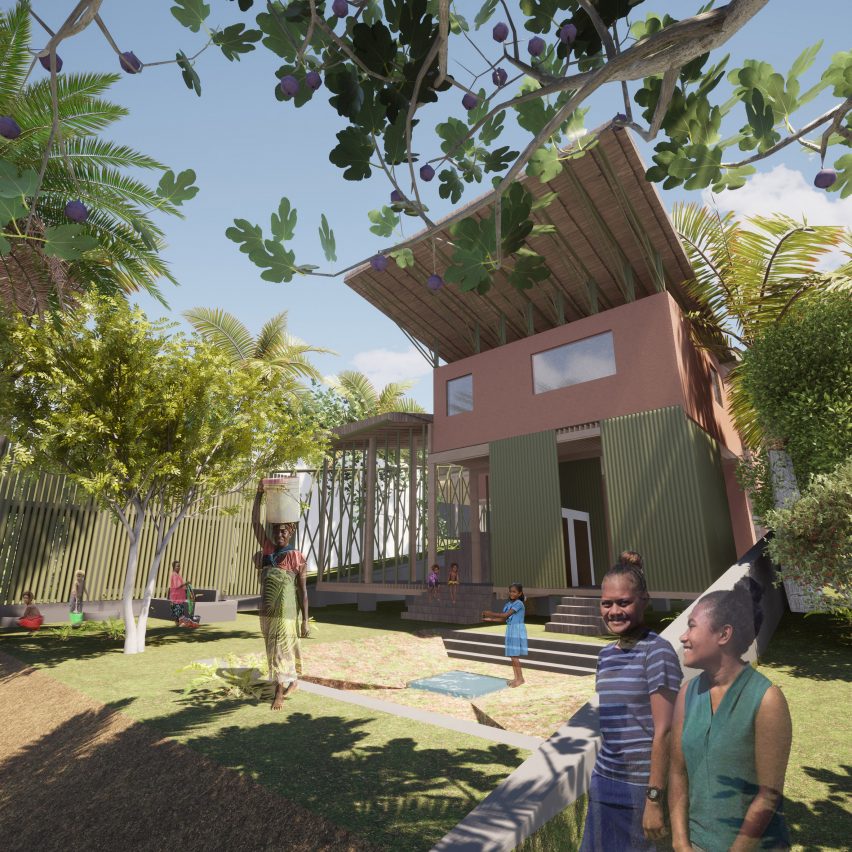
Lombi Women's Home by Alex Casar-Rodriquez and Sara Chafi
"In the city of Honiara, the Solomon Islands, inadequate water and hygiene infrastructure paired with oppressive gender roles and violence leaves young girls to negotiate a fragile and threatening environment.
"This project for Lombi women offers young pregnant women and mothers a space for empowerment by providing a reliable public water source, continuing education, living quarters, and a supportive community.
"Drawing inspiration from traditional building practices in the Solomon Islands, the shelter's multi-level organization creates public space to serve as an outreach platform for all girls in the community as well as private spaces for learning and healing."
Students: Alex Casar-Rodriguez and Sara Chafi
Course: Diploma Studio, Master of Architecture
Tutor: Betsy West, associate professor
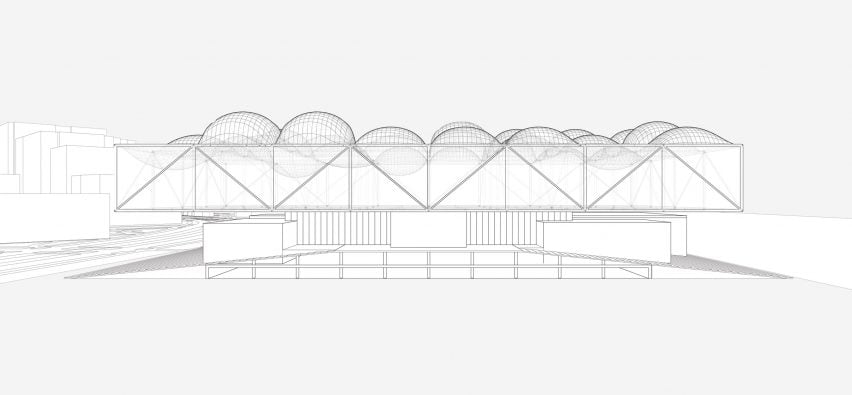
Non-Linear Story Telling: Museum of Stories by Amir Zarrinrad
"Most commemorative architecture, like museums and galleries, is based on linear circulation.
"By investigating different storytelling structures for this project, located on Pier 30 in San Francisco, allows the audience to interact with varying levels of narration.
"With a tetrahedral grid plan and transformable roof, exhibits are structured for the audience to curate their exhibition experience.
"Each exhibition room operates under different air pressures depending upon exhibit contents and the number of patrons attracted to a particular gallery.
"Such a strategy permits the audience to alter their environment by the way they move about the exhibits, while in turn influencing the gallery experience of others."
Student: Amir Zarrinrad
Course: Diploma Studio, Master of Architecture
Tutor: Dimitrios Papanikolaou, assistant professor
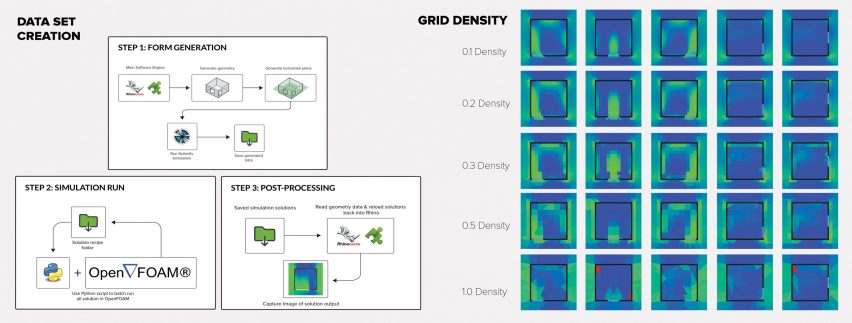
Generative Machine Learning Models for Airlow Predictions of Architectural Space by Fernando Claudio-Rodríguez
"This thesis aims to apply existing generative machine learning algorithms to process computational fluid dynamic (CFD) wind velocity simulations to yield shorter run times while maintaining a relatively high accuracy level.
"Training the model with a custom data set, and afterward comparing the results from the CFD engine to the images produced by the machine learning model anchors the significance of this study."
Student: Fernando Claudio Rodríguez
Course: Master Thesis, Master of Architecture + Master of Science in Information Technology
Advisors: Jefferson Ellinger (chair), Elizabeth McCormick, Chengde Wu and Minwoo Lee
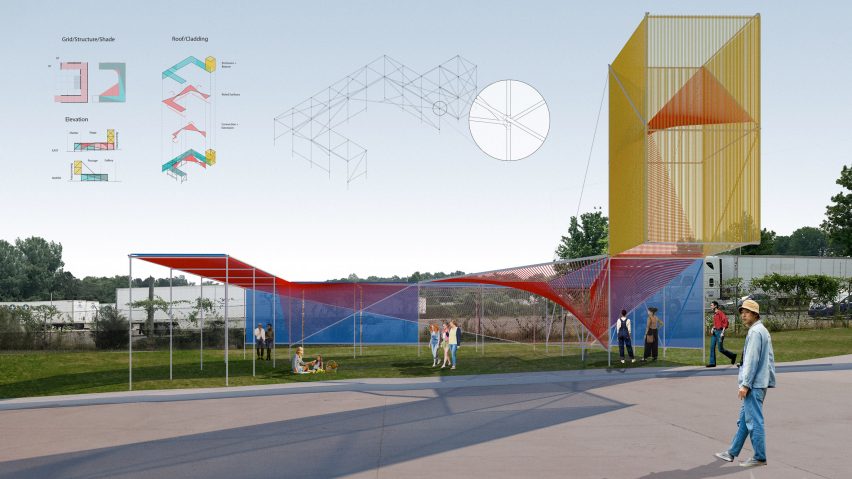
Sugar Creek Arts Event Lawn by Summer Design-Build Students
"Sugar Creek Arts is transforming an industrial site into a community arts hub led by developer Flywheel Group.
"Our project is to design and implement an iconic architectural element that will define, frame, and shade an outdoor event lawn on the site.
"The goal is to enhance a space that will sponsor and support multiple arts-related activities, events, and receptions while fostering greater integration of the building and its site, and the site with the Charlotte.
"When completed, the architecture is intended to animate the site with a unique and legible identity."
Students: Chris Bayliss, Kyle Brodfueher, Cami Carrera, Jake Froning, Ri Glal, Will Hutchinson, Will Merrigan, Michael Miles, Paige Pelletier, Aarati Podili, Bradley Seckler, Nick Sturm, Hunter Thurlo, Ryan Tillotson and Sam Woods
Course: Advanced Topics Studio, Master of Architecture
Tutor: Marc Manack, associate professor, SILO
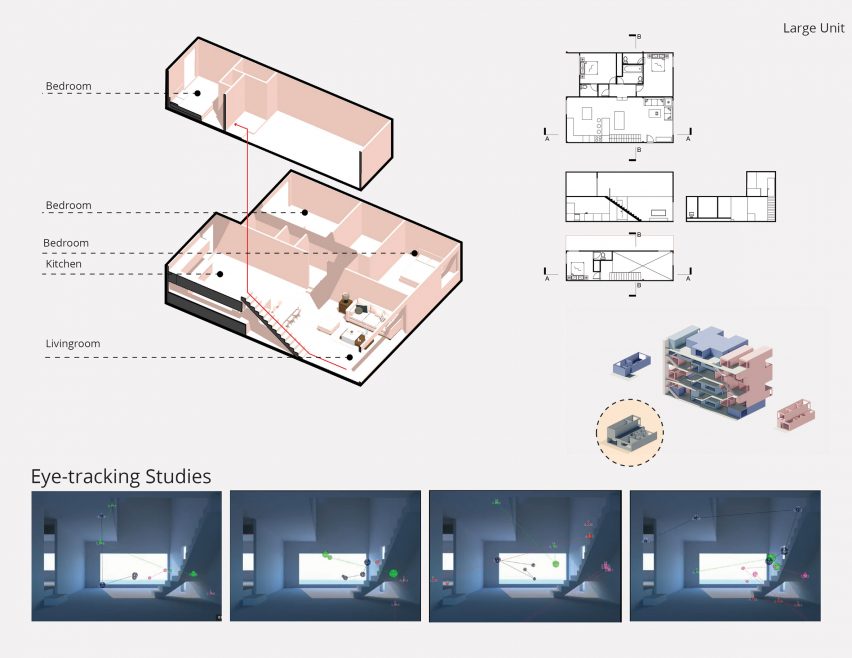
Yard-to-Yard by Mohammad Fasahat
"With the march to build ever denser, our modern cities there remains the need to house people in healthy and humane ways.
"This project utilizes research using current eye-tracking hardware and software to observe and collect impressions on how individuals perceive interior spatial realms.
The resulting data serves to design micro-units that are perceived larger than what their physical limits may suggest.
"Yard-to-Yard challenges the current trend for low density living by offering an expanding sense of dwelling that is equitable, dignified, and sustainable."
Student: Mohammad Fasahat
Course: Advanced Topics Studio, Master of Architecture
Tutor: Peter Wong, associate professor
Partnership content
This school show is a partnership between Dezeen and the University of North Carolina Charlotte School of Architecture. Find out more about Dezeen partnership content here.